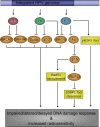HPV, hypoxia and radiation response in head and neck cancer
- PMID: 29493265
- PMCID: PMC6435089
- DOI: 10.1259/bjr.20180047
HPV, hypoxia and radiation response in head and neck cancer
Abstract
Over the last decades, the incidence of human papilloma virus (HPV) positive head and neck squamous-cell carcinoma (HNSCC) has significantly increased. Infection with high-risk HPV types drives tumourigenesis through expression of the oncoproteins E6 and E7. Currently, the primary treatment of HNSCC consists of radiotherapy, often combined with platinum-based chemotherapeutics. One of the common features of HNSCC is the occurrence of tumour hypoxia, which impairs the efficacy of radiotherapy and is a negative prognostic factor. Therefore, it is important to detect and quantify the severity of hypoxia, as well as develop strategies to specifically target hypoxic tumours. HPV-positive tumours are remarkably radiosensitive compared to HPV-negative tumours and consequently the HPV-positive patients have a better prognosis. This provides an opportunity to elucidate mechanisms of radiation sensitivity, which may reveal targets for improved therapy for HPV-negative head and neck cancers. In this review, we will discuss the differences between HPV-positive and HPV-negative head and neck tumours and methods of hypoxia detection and targeting in these disease types. Particular emphasis will be placed on the mechanisms by which HPV infection impacts radiosensitivity.
Figures


Similar articles
-
M2 macrophages reduce the radiosensitivity of head and neck cancer by releasing HB‑EGF.Oncol Rep. 2020 Aug;44(2):698-710. doi: 10.3892/or.2020.7628. Epub 2020 May 29. Oncol Rep. 2020. PMID: 32627036 Free PMC article.
-
EGFR overexpression increases radiotherapy response in HPV-positive head and neck cancer through inhibition of DNA damage repair and HPV E6 downregulation.Cancer Lett. 2021 Feb 1;498:80-97. doi: 10.1016/j.canlet.2020.10.035. Epub 2020 Oct 31. Cancer Lett. 2021. PMID: 33137407
-
AKT inhibition as a strategy for targeting hypoxic HPV-positive HNSCC.Radiother Oncol. 2020 Aug;149:1-7. doi: 10.1016/j.radonc.2020.04.048. Epub 2020 Apr 30. Radiother Oncol. 2020. PMID: 32361013
-
The radiobiology of HPV-positive and HPV-negative head and neck squamous cell carcinoma.Expert Rev Mol Med. 2020 Jul 2;22:e3. doi: 10.1017/erm.2020.4. Expert Rev Mol Med. 2020. PMID: 32611474 Free PMC article. Review.
-
Biological basis for increased sensitivity to radiation therapy in HPV-positive head and neck cancers.Biomed Res Int. 2014;2014:696028. doi: 10.1155/2014/696028. Epub 2014 Apr 3. Biomed Res Int. 2014. PMID: 24804233 Free PMC article. Review.
Cited by
-
Prognostic significance of uPA and uPAR expression in patients with cervical cancer undergoing radiotherapy.Oncol Lett. 2021 May;21(5):423. doi: 10.3892/ol.2021.12684. Epub 2021 Mar 29. Oncol Lett. 2021. PMID: 33850564 Free PMC article.
-
Radiation Therapy Improves Survival in Patients with Distant Metastatic Head and Neck Squamous Cell Carcinoma: A Retrospective Study.J Cancer. 2025 Jan 1;16(3):996-1007. doi: 10.7150/jca.105254. eCollection 2025. J Cancer. 2025. PMID: 39781346 Free PMC article.
-
Inhibiting NHEJ in HNSCC cell lines by the ligase IV inhibitor SCR130 has limited radiosensitizing effects.Sci Rep. 2025 May 22;15(1):17871. doi: 10.1038/s41598-025-03159-5. Sci Rep. 2025. PMID: 40404928 Free PMC article.
-
Enhanced Radiation Sensitivity of Human Papillomavirus-Driven Head and Neck Cancer: Focus on Immunological Aspects.Front Immunol. 2019 Dec 3;10:2831. doi: 10.3389/fimmu.2019.02831. eCollection 2019. Front Immunol. 2019. PMID: 31849993 Free PMC article. Review.
-
Active Immune Phenotype in Head and Neck Cancer: Reevaluating the Iso-Effect Fractionation Based on the Linear Quadratic (LQ) Model-A Narrative Review.Curr Oncol. 2023 May 8;30(5):4805-4816. doi: 10.3390/curroncol30050362. Curr Oncol. 2023. PMID: 37232820 Free PMC article. Review.
References
-
- Poole ME, Sailer SL, Rosenman JG, Tepper JE, Weissler MC, Shockley WW, et al. . Chemoradiation for locally advanced squamous cell carcinoma of the head and neck for organ preservation and palliation. Arch Otolaryngol Head Neck Surg 2001; 127: 1446–50. - PubMed
-
- Vaupel P, Kelleher DK, Höckel M. Oxygen status of malignant tumors: pathogenesis of hypoxia and significance for tumor therapy. Semin Oncol 2001; 28(2 Suppl 8): 29–35. - PubMed
Publication types
MeSH terms
Grants and funding
LinkOut - more resources
Full Text Sources
Other Literature Sources
Medical

